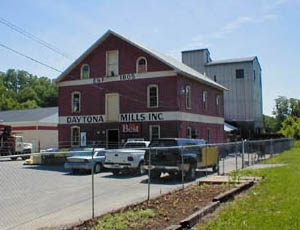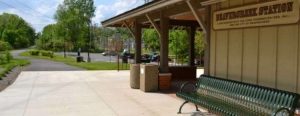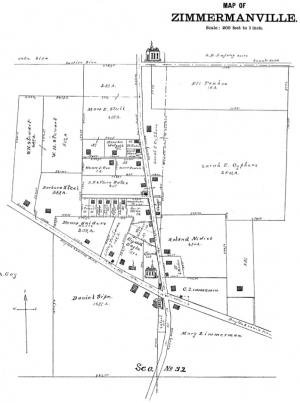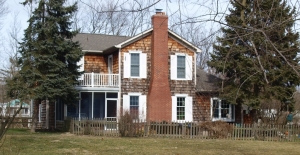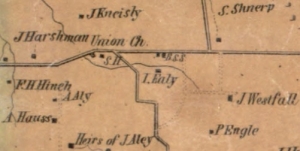Book
Displaying items by tag: Beavercreek
Loose pets and stray animals are becoming an almost daily feature on the local news and social media like The Beavercreek Buzz (our favorite!). Most are innocent escapees on an exploratory mission around the neighborhood, although unlike Disney movies, sometimes forget the way home. Others, fortunately none locally, end up on the first minutes of a the five o'clock news following an attack or on a late night TV commercial with Sarah McLachlan music playing in the background.
As you continue south on North Fairfield Road, you can clearly see Daytona Mills on your left. Daytona Mills continues as a business today!
Hidden in the woods immediately south of the creek is the location of the Schantz-Hagenbuch buildings just described. Turn right onto Research Boulevard/S.R. 835. At the stop sign turn left onto the S.R. 835 bypass / Research Blvd.
In 1921 the Hagenbuch’s sold the mill building to Ben Belden; he moved it piece-by-piece to the north side of the creek and switched it to electric power. The original building still stands and is known as the Daytona Mills. In the mid-1940’s, long before the development of the Coy Homestead Estates neighborhood, the original Jacob Coy cabin was purchased by Mrs. F.H. Hagenbuch and moved to their property and lovingly restored to period.
In the late 1800’s, John Schantz, who along with wife Mary bought the property in 1868, became frustrated when the mill dam, built of oak planks, broke one too many times. He abandoned the water wheel and converted the mill to steam power, channeling the excess into clumsy radiators in the house – they weren’t much to look at, but it became the first home in the area to have steam heat and shortly after, an indoor bathroom.
Near the house was a large barn; west of it stood the mill on the slope of the creek. Further west from the mill was a sawmill, and east of it was a frame building that was a smokehouse above and a springhouse below. The water is a cool 50°F and was used in the cooling of warm milk prior to use or shipment to the diaries. This building is known as the Solomon Shoup Springhouse and is the only springhouse known still to be standing in Beavercreek. Also nearby were a blacksmith shop and a carriage house.
https://beavercreekliving.com/book/itemlist/tag/Beavercreek?start=60#sigProIdb75020b196
Head south and turn into the parking area of Beavercreek Station at the 9/11 Memorial. This basin was previously known as Shoup’s Station, on the Pennsylvania rail line. Just south of the tracks was the Dayton and Xenia Traction Company Line, which traversed farmlands east to Xenia and followed what is now Patterson Road into Dayton. On the east side of North Fairfield Road is an access road that crosses the Little Beaver Creek. This leads to the Schantz-Hagenbuch Home, originally a small one-room brick house which George Shoup built for his son Solomon in 1810.
George had brought his family from Frederick, Maryland in the very early 1800’s to continue his milling trade. He constructed a large three story, three stone undershot water wheel mill on the south side of the creek with a daily capacity of forty barrels. Over the years, both the Shoup and Hagenbuch families added numerous additions. An enormous fireplace had a handwrought crane that swung over the fire. The bricks were all fired on site, just west of the home.
 September 11, 2001 Memorial Dedication
September 11, 2001 Memorial Dedication
September 11, 2001 Memorial Dedication
September 11, 2001 Memorial Dedication
 John Schantz Home and Mill
John Schantz Home and Mill
John Schantz Home and Mill
John Schantz Home and Mill
 1874 Map of Zimmermansville
1874 Map of Zimmermansville
1874 Map of Zimmermansville
1874 Map of Zimmermansville
https://beavercreekliving.com/book/itemlist/tag/Beavercreek?start=60#sigProIdb596fda103
Lifers still refer to this area as “Push On”, but no one knows the exact history of the name. Two stories seem to be most common, the first is that farmers driving cattle from Xenia to the Dayton slaughterhouses (On Springfield Street near the former ‘Stockyards Inn’) would rest the herd near the current intersection of Route 35 and North Fairfield Road before they would ‘Push On’ to Dayton. It is also told that train and traction (more on this shortly!) conductors would ask passengers if they were disembarking or if they would ‘Push On’ to Xenia - this is the most common story.
On the east side of the downhill grade is Meadowbridge Drive. Beaver-Vu bowling alley has been a long-time favorite of Beavercreek residents - especially in the 1970's when a billiard room was constructed. Original owner Cy Grilliot was an intimidating character who would stare down patrons at the desk until they mustered the courage to ask for his assistance. His saltiness may have come from customers enjoying too many libations and then rolling bowling balls down North Fairfield Road - names withheld to protect the accused!
Behind the bowling alley is a dental office complex that was for decades the Beaver-Vu skating rink, the first in the area that didn't offer hardwood flooring.
An Imperial Grocer and Goldman's Shopping Center were also nearby.
 Beaver Vu Interior
Beaver Vu Interior
Beaver Vu Interior
Beaver Vu Interior
 IGA Grocery
IGA Grocery
IGA Grocery
IGA Grocery
 New Businesses
New Businesses
New Businesses
New Businesses
 Dayton Stockyards
Dayton Stockyards
Dayton Stockyards
Dayton Stockyards
https://beavercreekliving.com/book/itemlist/tag/Beavercreek?start=60#sigProId7c6db20251
The area most now consider the center of Beavercreek was long ago known as the settlement of Cimmermanville, then Zimmermanville, and later shortened to Zimmerman. The first home built here was at the southeast corner of Dayton-Xenia and North Fairfield Roads for Jacob Zimmerman, for whom the village was named. In this home was the first grocery. He also kept a house for ‘the entertainment of travelers.’
This was the second-largest town in the township to Alpha. Zimmerman School #12 sat just west of the intersection and was led by Professor Frank Zimmerman in the early days. This was a rare two-room school with the older students in the Big Room and the younger in the Little Room. Well behaved students would be awarded the honor of ringing the school bell for recess, while those not-so-fortunate would lug coal and clean the ash pan.
 North Fairfield Road
North Fairfield Road
North Fairfield Road
North Fairfield Road
 Late 60's or early 70's
Late 60's or early 70's
Late 60's or early 70's
Late 60's or early 70's
 Zimmerman School
Zimmerman School
Zimmerman School
Zimmerman School
 Zimmerman in 1874
Zimmerman in 1874
Zimmerman in 1874
Zimmerman in 1874
https://beavercreekliving.com/book/itemlist/tag/Beavercreek?start=60#sigProIdc46f289e27
Continue east toward North Fairfield Road. The barn at Deal’s Landscaping was built in the 1850’s by the Miller family on Hanes Road, disassembled, and moved to this location in 1988.
Ahead on the right was the Hail & Hearty restaurant, which started as a Hasty Tasty, Char-Burger, The Shamrock, then Mama Bear's, and later Debra Lee’s, Naomi's, Grandpa's Cafe and most recently Woody’s Barbeque. The building was demolished in 2016 to make way for an automotive repair shop and strip center.
Does anyone remember a restaurant named The Omen?
https://beavercreekliving.com/book/itemlist/tag/Beavercreek?start=60#sigProId22e2db6e90
On Thursday, May 15, Jill Kincer, as president of the Beavercreek Historical Society, presented the Beavercreek Board of Education with a stone from the foundation of Beavercreek's first schoolhouse -- a schoolhouse built on land provided by Jacob Coy, for whom Beavercreek's Coy Middle School is named. This stone will be incorporated into the design of the district's new preschool building, which will be located on the site of the current Board of Education/Central Office Building at 3040 Kemp Road.
Mrs. Kincer's remarks to the Board follow:
On May 26, 2014, the city of Beavercreek hosted it's annual Memorial Day Event at Veteran's Memorial Park. The event kicked off with the St. Andrew Pipes and Drums rendition of Amazing Grace, followed by a welcome and opening remarks by Mayor Brian Jarvis and the Invocation by Pastor Paul Craig.
The American Legion Post 763 posted the Colors and VFW Post 8312 raised the Flags over the event followed by the Boy Scouts leading the audience in the Pledge of Allegiance.
Adjacent to the fire station is the Harshman-Zimmerman Cemetery, burials include one of the area’s first doctors, Dr. George Zimmerman, as well as several members of the Harshman family. Further east at 3685 Dayton-Xenia Road is a farm of nearly 49 acres that has been in the Durnbaugh family for in excess of 140 years! Near 3600 Dayton-Xenia Road was the location of the Rest Haven, built in 1924, famous for their live black bears!
Enjoy this diagnosis and treatment attributed to Dr. Zimmerman on March 26, 1801: "...your mother's illness is a catarrh or rhumatic fever and is caused by the stomach and is a stomach cough, although the Zelnkoder may come from the lungs, such as a sickness is not half as dangerous with old people as with younger ones. I wish wither her medicine your mother would take what I now tell you.
Take ½ gallon hard vinegar, 1 handful yssop, 1 handful fluellin, ½ oz. sea onion, 1 oz. gum amoniac boil it down to half then strain and take the same amount of honey and boil down to 1 pint. She should take 3 times a day, 1 Tbs. in a teacul of milkshotten...
There is another cure for such a sickness. Take a fresh laid egg, boil it in the urine of the patient, then 10-15 small holes in the egg, bury it in an anthill and whn the ants have eaten up the egg, the patient will be well."
 Durnbaugh Engagement
Durnbaugh Engagement
Durnbaugh Engagement
Durnbaugh Engagement
 Rest Haven Bears
Rest Haven Bears
Rest Haven Bears
Rest Haven Bears
 Rest Haven Sold
Rest Haven Sold
Rest Haven Sold
Rest Haven Sold
https://beavercreekliving.com/book/itemlist/tag/Beavercreek?start=60#sigProId38d9966473
Prior to the construction of I-675, this area was largely undeveloped, save for a few residential streets that traversed the current highway land to the north, to the south was once a horse track! On the west side of the highway was a train trestle, now an overpass of the Creekside Trail Bikeway. For decades, Beavercreek High School and Carroll High School students (allegedly) would alternate painting the bridge and concrete supports in support of their school’s athletic teams. The beautiful white home with the green roof on the south side was the center of the 160 acre Aaron Coy farm.
Turn around in the parking lot of Walnut Grove Country Club and return west past the 5/3rd Gateway Park and Ride Facility.
 Article of I-675 Construction
Article of I-675 Construction
Article of I-675 Construction
Article of I-675 Construction
 Article about the graffiti on the train trestle
Article about the graffiti on the train trestle
Article about the graffiti on the train trestle
Article about the graffiti on the train trestle
 One of the final pictures of the train trestle
One of the final pictures of the train trestle
One of the final pictures of the train trestle
One of the final pictures of the train trestle
https://beavercreekliving.com/book/itemlist/tag/Beavercreek?start=60#sigProIde389e9b05d
Head south on Grange Hall Road, the intersection of Dayton-Xenia Road features the Charity Grange No. 1208 Building, currently known as the Beavercreek Event Center. This Hawker Church-based Grange was a spin-off of the Beaver Grange which met at Beaver Church east of Alpha.
Early Granges were established as a farmer’s collective for bulk purchasing plows, washing machines, coffee, sugar, tea and other commodities. This fraternity stressed organization, education, cooperation and legislation as a remedy to some of the farm and national problems. Charity Grange No. 1208 was organized in 1875 and originally met in the basement of Hawker Church. This block building replaced a two-story frame building in 1953.
https://beavercreekliving.com/book/itemlist/tag/Beavercreek?start=60#sigProId629859a8e1
Turn right on Grange View Drive and then right onto Timberline Drive. In 1855, this was Ealy (Aley) land including small sawmill on present day Longview Drive that was known as St. M. Located at 3937 Timberline Drive is a stately home formerly on a 179 acre estate built by John Aley in 1835. A unique feature of the home is the original double pie stairway. Most of the rooms have original windows and walnut woodwork. In 1874, it was the home of Valentine Cosler, an avid supporter of Hawker Church. Charles Beaver also bought this farm in 1948, sub-divided and developed it into Knollwood Estates.
You’re approaching Grange Hall Road. At the stop sign, glance to your right and see the approximate location of the Engle Sawmill at the intersection of Summerfield Drive.
https://beavercreekliving.com/book/itemlist/tag/Beavercreek?start=60#sigProId0b78e90ac1
Turn left onto LaGrange Road and then right onto Knollwood Drive. The home at 3912 Knollwood Drive is the Engle-Wagley House, built around an 1803 log cabin originally constructed by Jacob Karch on land owned previously by Isaac Spinning. In 1852 it was acquired by Peter Engle and in 1880 by David Engle, owner of a nearby sawmill. David performed the initial renovations including adding a second story.
It was purchased from the Engle family in 1950 by local developer Charles Beaver. The home has had numerous renovations and additions honoring the heritage of the property, uncovering walls to expose the well preserved logs.
Turning right on Grange Hall Road, it’s interesting to note that this was not the original location of the road; the 1874 map shows it was one block east which is now known as LaGrange Road (see image below), while the 1855 map (above) has it angling west toward Aley Church, south of the woods.
The white frame home on the southeast corner dates prior to 1880 and faces west, toward the 1855 road location. On the west side of Grange Hall at the intersecion of LaGrange Road is the location of the initial Aley School #3.
On the 1855 map above, the initials B.S.S stands for blacksmith shop and S.H. stands for schoolhouse.
https://beavercreekliving.com/book/itemlist/tag/Beavercreek?start=60#sigProIdcfbc0c1bb3
Freedom's Call, a cost-free family orientated celebration, will have something for everyone. For adults, there will be live music from St. Andrews Pipes & Drums, The Kate Hastings Band, This Side Up and the popular Air Force Band of Flight. To harness young ones energy, there will be a children's play area with various activities. For those seeking food and drink, local vendors will be on hand to satisfy your request. The night will be capped off with a spectacular fireworks display lighting the night sky, starting at 10:00 p.m. Come out and enjoy the evening with the family at this Star Spangled event!
Heading west on New Germany-Trebein Road, you’re crossing land that was owned early on by the Harshman, Reece, Koogler and Hotopp families amongst others. The intersection at North Fairfield Road was largely undeveloped until the late 1980’s when the Mall at Fairfield Commons was constructed. The building of the mall was quite controversial. Beavercreek was growing at a rapid pace following the installation of the I-675 bypass around Dayton. Though the growth was likely inevitable, long-time residents initiated a campaign to ‘Stop Malling Beavercreek’ in the hopes of retaining the distant suburban feel they had enjoyed for decades.
The photo above, provided by Eric Nicholson, was taken at the intersection of North Fairfield and New Germany-Trebein Roads. It is believed to be looking northeast, toward the current shopping center that includes Lowe's, Best Buy and Kohl's.
 When crossing North Fairfield Road, New Germany-Trebein Road changes its name to Pentagon Boulevard, which formerly connected to Germany Lane in the town of New Germany across the highway. Looking at an aerial map, you can pretty clearly see where the roads previously met.
When crossing North Fairfield Road, New Germany-Trebein Road changes its name to Pentagon Boulevard, which formerly connected to Germany Lane in the town of New Germany across the highway. Looking at an aerial map, you can pretty clearly see where the roads previously met.
With $5 million remaining after the completion of its 2008 bond-funded facilities program, the Beavercreek City Schools Board of Education voted Thursday evening to address some of the district’s outstanding facilities needs, approving four construction projects that include:
Are you as SICK of the stink bug invasion of Beavercreek as we are?! HATE THEM!! I think we were all hoping that our miserable winter would have taken care of them... but research and reality is proving that to not be the case. Rob Venette, a Forest Service Research Biologist reports that temperatures must reach -20°F to even faze them (nor the dreaded Emerald Ash Borer). So what we've experienced is a little correction that may have thinned their ranks, but as the warm weather returns - so are they.
So what can you do?
Navigation
Latest Blog Posts
- Just Don't Call Us Late For Dinner...
- Remember When...
- What A Long, Strange Trip It's Been...
- Snow Down = Slow Down
- School Bus Safety - Just Do It!
- Stevenson Road Covered Bridge
- Our Road Crews Are Worth Their Salt!
- The Most Colorful Of Seasons!
- Popcorn Fest! - Then And Now
- Pre-School Paradise!
- Remembering Riffles
- Ten Year Anniversary Of The Beaver Statues


